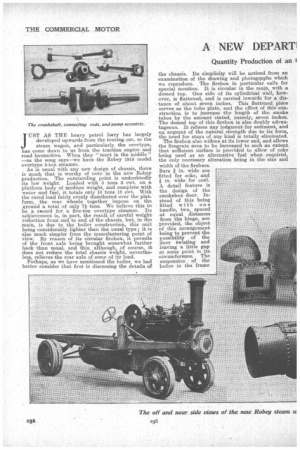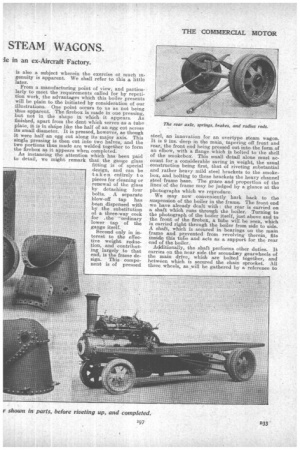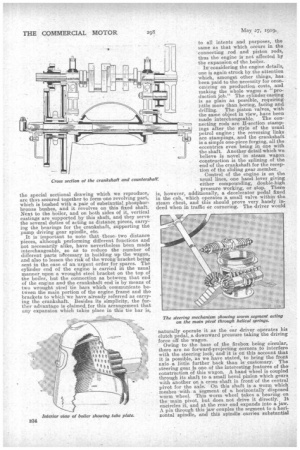A NEW DEPART' STEAM WAGONS.
Page 10

Page 11

Page 12

Page 13

If you've noticed an error in this article please click here to report it so we can fix it.
Quantity Production of an le in an ex-Aircraft Factory.
JUST AS THE heavy petrol lorry has largely developed upwards from the touring car, so the steam wagon, and particularly the overtype, has come down to us from the traction engine and road locomotive. When they "meet in the middle " ,as the song says—we have the Robey 1919 model overtype 5-ton steamer.
As is usual avith any new design of chassis, there is much that is worthy of note in the new Robey production. The outstanding point is undoubtedly its low weight. Loaded with 6 tons 3 cwt. on a platform body of medium weight, and complete with water and fuel, it totals only 10 tons 18 cwt. With the rated load fairly evenly distributed over the plat-. form,. the rear wheels together impose on the ground a total of only 7-itons. We believe this to be a record for a five-ton overtype steamer. Its achievement is, in part, the result of careful weight reduction from end to end of the chassis, but, in the main, is due to the boiler construction, this unit being considerably lighter than the usual type i it is also much simpler from the manufacturing point of view. By reason of its circular firebox, it permits of the front axle being brought somewhat further back than usual, and this, although: of course, it does not reduce the total chassis weight, nevertheless, relieves the rear axle of some of its load.
Perhaps, as we have mentioned the boiler, we had better consider that first in discussing the details of the chassis. Its simplicity will be noticed from an examination of the drawing and photographs which we reproduce. The firebox in particular calls for special Mention. It is circular in the main, with a domed top. One side of its cylindrical wall, however, is flattened, and is carried inwards for a. distance of about seven inches. This flattened piece serves as the tube plate, and the effect of this construction is to increase the length of the smoke tubes by the amount stated, namely, seven inches. The domed top of this firebox is also doubly advantageous. It refuses any lodgment for sediment, and on. account of the natural strength due to its form, the need for stays of any kind is totally eliminated. The firebox also widens at its lower end, and allows the firegrate area to be increased to such an extent that sufficient surface is provided to allow of coke being used as an alternative fuel when required, the only necessary alteration being in the size and width of the firebars.
Bars in. wide are fitted for coke, and in. wide for coal.
A detail feature is the design of the smokebox door. In stead of this being fitted with one handle, two, spaced at equal distances from the hinge, are provided, the object of this arrangement heing to prevent the possibility of the door twisting and leaving a little gap at some point in its circumference. The suspension of the boiler in the frame is also a subject wherein the exercise ot much ingenuity is apparent. We shall refer to this a little later.
From a manufacturing point of view, and particularly to meet the requirements called for by repetition work, the advantages which this boiler presents will be plain to the initiated by consideration of our illustrations. One point occurs to us as not being thus apparent. The firebox is made in one pressing, but not in the shape in which it appears. As finished, apart from the dent which serves as a tube plate, it is in shape like the half of an egg cut across its small diameter. It is pressed, however, as though it were half an egg cut along its major axis. This single pressing is then cut into two halves, and the two portions thus made are welded together to form the firebox as it appears when completed.
As instancing the attention which has been paid
to detail, we might remark that the gauge glass fitting is of special design, and can be taken entirely to pieces for cleaning or renewal of the glass by detaching four bolts. A separate blow-off tap has been dispensed with by the substitution of a three-way cock for .the -ordinary lower tap of the gauge itself.
Second only in interest to the effective weight reduction, and contributing largely to that end, is the frame design. This component is of pressed
steel, an innovation for an overtype steam wagon. It is 9 ins, deep in the main, tapering off front and rear, the front end being pressed out into the form of an elbow, with a flange which is bolted to the shell of the smokebox. This small detail alone must account for a considerable saving in weight, the usual construction being first, that of riveting substantial and rather heavy mild steel brackets to the smokebox, and bolting to these brackets the heavy channel steel frame base. The grace. and proportion of the lines of the frame may be judged by a glance at the photographs which we reproduce.
We may now conveniently hark back to the suspension of the boiler in the frame, The front end we have already dealt with : the rear is carried on a shaft which runs through the boiler. Turning to the photograph of the boiler itself, just above and to the front of the firebox, a tube will be seen, which is carried right through the boiler from side to side. A shaft, which is secured in bearings on the main frame and prevented from revolving therein, fits inside this tube and acts as a support for the rear end of the boiler.
Additionally, the shaft performs other duties. It carries on the near side the secondary gearwheels of the main drive: which are bolted together, and between which is secured the chain sprocket. All three wheels, as will be gathered by a reference: to the special sectional drawing which we reproduce, are thus secured together to form one revolving part, which is bushed with a pair of substantial phosphorbronze bushes, and it revolves on this fixed shaft. Next to the boiler, and an both sides of it, vertical castings are supported by this shaft, and they servethe several duties of acting as distance pieces, carrying the bearings for the crankshaft, supporting the pump driving gear spindle, etc.
It is important to note that these. two distance pieces, although performing different functions and not necessarily alike, have nevertheless been made interchangeable, so as to reduce the number of different parts necessary in building up the wagon, and also to lessen the risk of the wrong'bracket being sent in the case of an urgent order for !Tares. The cylinder end of the engine is carried in the usual manner upon a wrought steel bracket on the top of the boiler, but the connection as between that end of the engine andy the crankshaft end is by means of two wrought steel tie bars which communicate betWeen the main portion of the engine frame and the brackets to which we have already referred as carrying the crankshaft. Besides its simplicity, the further advantage is claimed for this arrangement that any expansion which takes place in this tie bar is,
to all intents and purposes, the same as that which occurs in the 'connecting rod and piston rods, thus the engine is not affected by the expansion of the boiler.
In considering the engine details, one is again struck by the attention which, amongst other things, has been paid to the necessity for economizing on production costs, and making the whole wagon a "production job." The cylinder casting is as plain as possible requiring little more than boring, and drilling. The piston valves, with the same object in view, have been made interchangeable. The connecting rods are II-section stampings after the style of the usual petrol engine ; the reversing links are stampings, and the crankshaft is a simple one-piece forging, all the eccentrics even being an one with the shaft. Another detail which we believe is novel in steam wagon construction is the splitting of the end of the crankshaft for the reception of the sliding gear member. Control of the engine is on the usual linea, one hand lever giving either compounding, double-high pressure working, or stop. There is, however, additionally, a decelerator pedal fixed in the cab, which operates a small valve within the steam chest, and this should prove very handy indeed when in traffic or cornering. The driver would naturally operate it as the car driver operates his clutch pedal,.a downward pressure taking the driving force off the wagon. Owing to the base of the firebox being circular, there are no forward-projecting corners to interfere with the steering lock, and it is on this aecount that it is possible, as we have stated, to bring the front axle i
a little further back than s customary. The steering geas is one of the interesting features of the construction Of this wagon. A hand wheel is coupled through its shaft to a small bevel pinion which gears with another on a cross shaft in front of the central pivot for the axle. On this shaft is a worm which meshes -with a segment of a. horizontally disposed worm wheel. This worm wheel takes a bearing, on the--main pivot, but does not drive it directly. It encircles it, and at the rear end expands into a jaw. A pin through this jaw couples the segment to a horizontal spindle, and this spindle carries substantial helical springs which bear at their outer ends against nuts on the spindle, and at their inner ends against brackets -which are integral with the central pivot of the axle. The result is a steering gear with practically no backlash, while, at the same time, the intervention of the springs prevents the direct transmission of road shocks to the hands of the driver. As regards detail, it is worthy of note that, at all points where the pivot casting bears on the axle, double steel wearing pads are fitted, one at each possible wearing point on the axle and on the corresponding surface of the pivot. The preliminary front axle which we saw was a forging, but dies are being, got out, and it is intended, iri future, that this unit shall 'be in keeping with most of the standard steel parts on the Wagon, a stamping.
• The rear axle does not differ to any considerable extent from standard steam wagon design. It is substantial, and the arrangement of the differential gear and sleeve are such that the spring-pads and bearings are interchangeable one with another. The design of the radius rods should be noted, particularly the socket ends, which permit of ready adjustfluent, and are strong, whilst being at the same time neat and light.
The brakes 'strike a new note. Only one shoe is carried within each wheel. The drum is as large as possible, being, as a matter of,,fact, a steel ring, only separated from the rim of the wheel itself by an air space of about half an inch. The shoes themselves are operated by means of a, pedal fitted with a heelreleased pawl working in a ratchet quadrant An ingenious and simple compensating gear is carried at the lower end of the pedal lever, and adjustment of either shoe is readily achieved through the holes in the disc wheels.
The construction of the wheels is worthy of more than a passing mention. Reference toour illustrations will show their neatness, their substantial and massive appearance. They :sae built of two convex discs which are stamped with holes in the centre for the hub, and they are then riveted together near their -extremities. The hubs are then east ni place, provision being made by serrating the edges of the central holes in the stampings to obviate the possibility of them ever coming loose. Attention should be directed to the well-rounded corners in the stampings, and it should be pointed out that the wheels. are built up and the flanges on the discs turned before the rims are actually shrunk on and riveted in place. It remains now only to make brief reference to ,general details. The water tank is semi-circular in shape, and has been brought well forward with the idea of reducing the load on the rear wheels. This seems to be such an obvious procedure that one wonders it has not been done before. The top of the tank., serves also as the base of the coal bunker. Lubrications throughout, from engine—with the exception of the cylinders—to wheel hubs, is by means of lubricators which are closed by spring-controlled pa.wis. ..IFor the cylinders a dual system is adopted of independent mechanical and automatic lubricators of the displacement type. The driver's position is well up in the cab, so that he has a ,good "driver's eye" view. One object of the design has been that of rendering the wagon -capable of being operated by one man, to which end the provision of the decelesa,tor pedal must contribute very considerably.
It is anticipated that at least one of these wagons will be on view at the Royal Show in Cardiff. Delivery of the wagon we saw is to take place this week. Others on order will follow in quick succession, as quantity production, as we observed, is already in progress. The main erecting shop of the aircraft department of Robey's, Ltd., Lincoln, is -to be devoted entirely to the assembling of these wagons, so that we should, within a very short time, see on the road, considerable numbers of examples of this latest development in the steam wagon practice, which is striking, both from the point of view of general design, and also on account of the method of the manner of its production.
Naturally, the chassis is adapted for any type of body, but we were particularly interested in a _special tipping gear h,isdraulieally operated. The ram is a telescopic one in three stages. Water is supplied from the boiler feed pump, a special three-way cock being provided to divert the water" to' the ram. This same cock also provides for the return of the water to the tank when the body is being restored to its normal position. Another feature is the provision of two fulcra , about which the body tips—the trunnions supporting the body about midway, and the pivot placed further back to allow a big tipping angle on a frame of ample length.






















